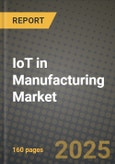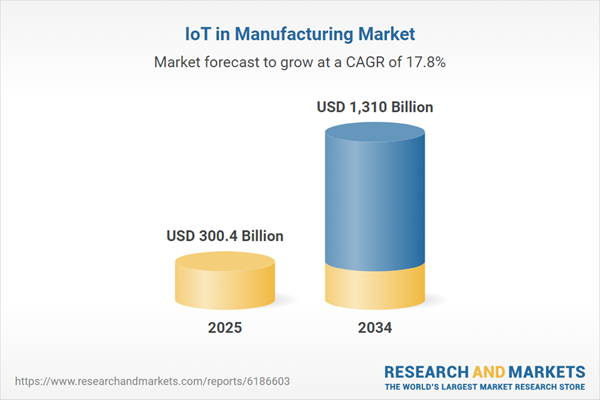The IoT in Manufacturing Market integrates connected sensors, intelligent machines, and real-time data analytics into manufacturing environments to improve productivity, efficiency, and operational visibility. Known as the foundation of Industry 4.0, IoT allows manufacturers to remotely monitor equipment, predict maintenance needs, optimize energy consumption, and automate quality control. From discrete to process manufacturing, IoT enables smarter supply chains, leaner production systems, and more agile operations. By combining machine data with cloud analytics and artificial intelligence, manufacturers gain actionable insights that help reduce downtime, ensure worker safety, and meet sustainability goals. As factories worldwide adopt digital transformation initiatives, IoT is rapidly becoming an essential layer in modern manufacturing ecosystems.
The IoT in manufacturing market expanded through accelerated adoption across automotive, electronics, pharmaceuticals, and heavy machinery sectors. Manufacturers invested in IoT-enabled predictive maintenance to reduce unplanned downtime, using sensor data to monitor motor temperature, vibration, and power consumption. Companies like Siemens, PTC, and Rockwell Automation rolled out integrated platforms combining IoT with AI and digital twins. Supply chains benefited from real-time tracking of raw materials and WIP (work-in-progress) items. Smart safety systems using wearables and proximity sensors were implemented on shop floors to prevent collisions and hazardous incidents. In addition, green manufacturing gained traction, with IoT systems monitoring emissions, water usage, and energy efficiency in real-time for environmental compliance and ESG reporting.
The market is expected to grow through AI-enhanced process automation, edge computing, and greater integration with ERP and MES platforms. Self-healing machinery and autonomous production lines will use IoT data and machine learning to adjust workflows dynamically. Industrial digital twins will simulate factory performance in real time, allowing operators to test scenarios before implementation. Cloud-to-edge orchestration will become essential for balancing latency-sensitive decisions and long-term data storage. Smaller manufacturers will adopt IoT through plug-and-play solutions tailored to mid-sized operations. Meanwhile, workforce training will shift to mixed-reality tools supported by IoT data, enhancing skills development and machine interaction. The future of manufacturing will be deeply connected, increasingly autonomous, and driven by IoT intelligence from the plant floor to the C-suite.
Key Insights: IoT In Manufacturing Market
- The analyst highlights the rise of digital twins in manufacturing, where IoT sensor data feeds virtual replicas of production lines for real-time simulation, predictive modeling, and dynamic process optimization.
- Edge computing is trending, allowing manufacturers to analyze data locally at the machine level, reducing latency and bandwidth costs while enabling real-time decision-making on the shop floor.
- According to the analyst, green manufacturing is gaining traction, with IoT platforms helping companies track energy usage, waste output, and emissions in real time to support sustainability goals and ESG compliance.
- Predictive maintenance continues to grow as a key use case, leveraging vibration, temperature, and pressure data to anticipate failures and reduce costly downtime across machinery and plant assets.
- Integration of IoT with MES and ERP systems is trending, enabling end-to-end visibility across operations, from production metrics to inventory levels and order fulfillment cycles.
- The analyst identifies the need to minimize unplanned downtime and boost equipment efficiency as a primary driver for manufacturers investing in IoT-powered predictive maintenance and remote diagnostics.
- Digital transformation mandates, including Industry 4.0 and smart factory initiatives, are pushing companies to adopt IoT solutions for automation, process transparency, and data-driven operations, says the analyst.
- The analyst notes that competitive pressures and customer demands for product customization are encouraging agile manufacturing, where IoT supports real-time scheduling and flexible production lines.
- Rising regulatory pressure on emissions, worker safety, and energy consumption is accelerating IoT adoption for compliance tracking, reporting, and environmental performance improvements.
- The analyst highlights legacy equipment integration as a major barrier, where older machines lack native IoT capabilities and require costly retrofits or sensor add-ons to connect to modern data platforms.
- According to the analyst, cybersecurity threats targeting operational technology (OT) environments are rising, making secure device authentication, encrypted data transfer, and continuous monitoring critical for IoT deployments.
IoT In Manufacturing Market Segmentation
By Component
- Solution
- Platform
- Service
By Vertical
- Energy and Utilities
- Automotive
- Food and Beverages
- Aerospace and Defense
- Chemicals and Materials
- High-Tech Products
- Healthcare
By Platform
- Device Management Platform
- Application Management Platform
- Connectivity Management Platform
By Application
- Process Optimization
- Predictive Maintenance
- Asset Management
- Workforce Management
- Emergency and Incident Management
- Logistics and Supply Chain Management
- Inventory Management
Key Companies Analysed
- Microsoft Corporation
- SAP SE
- Robert Bosch GmbH
- International Business Machines Corporation
- Cisco Systems Inc.
- General Electric Company
- Huawei Technologies Co. Ltd.
- PTC Inc.
- Zebra Technologies Corporation
- Siemens Aktiengesellschaft
- Rockwell Automation Inc.
- Wind River Systems Inc.
- Schneider Electric SE
- ClearBlade Inc.
- Mocana Corporation
- Impinj Inc.
- Uptake Technologies Inc.
- PalleTech LLC
- ELMODIS Sp. z o.o.
- Water.IO Inc.
- SensEye LLC
- ARCSTONE Pte. Ltd.
- SupraControl Technologies Inc.
- Software AG
- Texas Instruments Incorporated
- Hitachi Ltd.
- Konux GmbH
- Honeywell International Inc.
- Intel Corporation
- ABB Ltd.
- Mitsubishi Electric Corporation
- Fujitsu Limited
- Accenture plc
- Oracle Corporation
- Hewlett Packard Enterprise Development LP
- Dell Technologies Inc.
- Amazon Web Services Inc.
- Fanuc Corporation
- Kuka AG
- Yaskawa Electric Corporation
IoT In Manufacturing Market Analytics
The report employs rigorous tools, including Porter’s Five Forces, value chain mapping, and scenario-based modeling, to assess supply-demand dynamics. Cross-sector influences from parent, derived, and substitute markets are evaluated to identify risks and opportunities. Trade and pricing analytics provide an up-to-date view of international flows, including leading exporters, importers, and regional price trends.Macroeconomic indicators, policy frameworks such as carbon pricing and energy security strategies, and evolving consumer behavior are considered in forecasting scenarios. Recent deal flows, partnerships, and technology innovations are incorporated to assess their impact on future market performance.
IoT In Manufacturing Market Competitive Intelligence
The competitive landscape is mapped through proprietary frameworks, profiling leading companies with details on business models, product portfolios, financial performance, and strategic initiatives. Key developments such as mergers & acquisitions, technology collaborations, investment inflows, and regional expansions are analyzed for their competitive impact. The report also identifies emerging players and innovative startups contributing to market disruption.Regional insights highlight the most promising investment destinations, regulatory landscapes, and evolving partnerships across energy and industrial corridors.
Countries Covered
- North America - IoT In Manufacturing market data and outlook to 2034
- United States
- Canada
- Mexico
- Europe - IoT In Manufacturing market data and outlook to 2034
- Germany
- United Kingdom
- France
- Italy
- Spain
- BeNeLux
- Russia
- Sweden
- Asia-Pacific - IoT In Manufacturing market data and outlook to 2034
- China
- Japan
- India
- South Korea
- Australia
- Indonesia
- Malaysia
- Vietnam
- Middle East and Africa - IoT In Manufacturing market data and outlook to 2034
- Saudi Arabia
- South Africa
- Iran
- UAE
- Egypt
- South and Central America - IoT In Manufacturing market data and outlook to 2034
- Brazil
- Argentina
- Chile
- Peru
Research Methodology
This study combines primary inputs from industry experts across the IoT In Manufacturing value chain with secondary data from associations, government publications, trade databases, and company disclosures. Proprietary modeling techniques, including data triangulation, statistical correlation, and scenario planning, are applied to deliver reliable market sizing and forecasting.Key Questions Addressed
- What is the current and forecast market size of the IoT In Manufacturing industry at global, regional, and country levels?
- Which types, applications, and technologies present the highest growth potential?
- How are supply chains adapting to geopolitical and economic shocks?
- What role do policy frameworks, trade flows, and sustainability targets play in shaping demand?
- Who are the leading players, and how are their strategies evolving in the face of global uncertainty?
- Which regional “hotspots” and customer segments will outpace the market, and what go-to-market and partnership models best support entry and expansion?
- Where are the most investable opportunities - across technology roadmaps, sustainability-linked innovation, and M&A - and what is the best segment to invest over the next 3-5 years?
Your Key Takeaways from the IoT In Manufacturing Market Report
- Global IoT In Manufacturing market size and growth projections (CAGR), 2024-2034
- Impact of Russia-Ukraine, Israel-Palestine, and Hamas conflicts on IoT In Manufacturing trade, costs, and supply chains
- IoT In Manufacturing market size, share, and outlook across 5 regions and 27 countries, 2023-2034
- IoT In Manufacturing market size, CAGR, and market share of key products, applications, and end-user verticals, 2023-2034
- Short- and long-term IoT In Manufacturing market trends, drivers, restraints, and opportunities
- Porter’s Five Forces analysis, technological developments, and IoT In Manufacturing supply chain analysis
- IoT In Manufacturing trade analysis, IoT In Manufacturing market price analysis, and IoT In Manufacturing supply/demand dynamics
- Profiles of 5 leading companies - overview, key strategies, financials, and products
- Latest IoT In Manufacturing market news and developments
Additional Support
With the purchase of this report, you will receive:- An updated PDF report and an MS Excel data workbook containing all market tables and figures for easy analysis.
- 7-day post-sale analyst support for clarifications and in-scope supplementary data, ensuring the deliverable aligns precisely with your requirements.
- Complimentary report update to incorporate the latest available data and the impact of recent market developments.
This product will be delivered within 1-3 business days.
Table of Contents
Companies Mentioned
- Microsoft Corporation
- SAP SE
- Robert Bosch GmbH
- International Business Machines Corporation
- Cisco Systems Inc.
- General Electric Company
- Huawei Technologies Co. Ltd.
- PTC Inc.
- Zebra Technologies Corporation
- Siemens Aktiengesellschaft
- Rockwell Automation Inc.
- Wind River Systems Inc.
- Schneider Electric SE
- ClearBlade Inc.
- Mocana Corporation
- Impinj Inc.
- Uptake Technologies Inc.
- PalleTech LLC
- ELMODIS Sp. z o.o.
- Water.IO Inc.
- SensEye LLC
- ARCSTONE Pte. Ltd.
- SupraControl Technologies Inc.
- Software AG
- Texas Instruments Incorporated
- Hitachi Ltd.
- Konux GmbH
- Honeywell International Inc.
- Intel Corporation
- ABB Ltd.
- Mitsubishi Electric Corporation
- Fujitsu Limited
- Accenture PLC
- Oracle Corporation
- Hewlett Packard Enterprise Development LP
- Dell Technologies Inc.
- Amazon Web Services Inc.
- Fanuc Corporation
- Kuka AG
- Yaskawa Electric Corporation
Table Information
| Report Attribute | Details |
|---|---|
| No. of Pages | 160 |
| Published | October 2025 |
| Forecast Period | 2025 - 2034 |
| Estimated Market Value ( USD | $ 300.4 Billion |
| Forecasted Market Value ( USD | $ 1310 Billion |
| Compound Annual Growth Rate | 17.8% |
| Regions Covered | Global |
| No. of Companies Mentioned | 40 |









